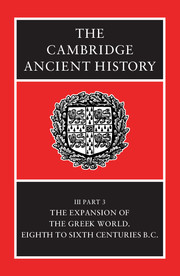Book contents
- Frontmatter
- Contents
- List of maps
- List of text-figures
- Preface
- 36a The Greeks in the Near East
- 36b The Greeks in Egypt
- 36c Cyprus
- 36d The Cypriot syllabary
- 37 The colonial expansion of Greece
- 38 The western Greeks
- 39a The eastern Greeks
- 39b Crete
- 39c Cretan Laws and Society
- 39d Euboea and the Islands
- 40 Illyris, Epirus and Macedonia
- 41 Central Greece and Thessaly
- 42 The Peloponnese
- 43 The growth of the Athenian state
- 44 The Tyranny of Pisistratus
- 45a Economic and social conditions in the Greek world
- 45b The material culture of Archaic Greece
- Chronological Table
- BIBLIOGRAPHY
- Index
- References
42 - The Peloponnese
Published online by Cambridge University Press: 28 March 2008
- Frontmatter
- Contents
- List of maps
- List of text-figures
- Preface
- 36a The Greeks in the Near East
- 36b The Greeks in Egypt
- 36c Cyprus
- 36d The Cypriot syllabary
- 37 The colonial expansion of Greece
- 38 The western Greeks
- 39a The eastern Greeks
- 39b Crete
- 39c Cretan Laws and Society
- 39d Euboea and the Islands
- 40 Illyris, Epirus and Macedonia
- 41 Central Greece and Thessaly
- 42 The Peloponnese
- 43 The growth of the Athenian state
- 44 The Tyranny of Pisistratus
- 45a Economic and social conditions in the Greek world
- 45b The material culture of Archaic Greece
- Chronological Table
- BIBLIOGRAPHY
- Index
- References
Summary
Some problems of chronology
When the Pleiades, daughters of Atlas, rise, begin your harvesting; and when they are about to set, begin your ploughing. Forty days and forty nights they are in hiding, but as the year revolves they appear again, when your sickle is first being sharpened
(Hesiod, Works and Days 383)Every shepherd and every farmer needs to know the details of the seasons and the tally of the years. Although literacy lapsed in the Dark Age, men remained numerate and counted the lunar months, each within his own small group. When these groups coalesced into a community or state, or when they engaged in a joint activity, a common standard of time-reckoning was needed. Each state created its own calendar, naming the months by a number or a deity or a festival and beginning the year wherever it pleased; occasionally a month-name, such as the Carnean month in honour of Apollo Carneus, was common to several states, but usually each state drew its names from its own sources and sometimes even had Mycenaean names. As trade and intercourse developed, the need to label the years within a community was met by naming each year after an ‘eponymous’ official, whether priest or magistrate, and keeping a list of the names, e.g. that of Elatus as the first eponymous ephor of Sparta in 754 B.C. (Plut. Lyc. 7). A system which several states could share was devised at Olympia, where the festival was held once every four years and a sacred truce for its duration was observed by the participating states. The festival years were numbered consecutively and named after each winner of the foot-race (stadion), the first Olympiad in 776 B.C. being that of Coroebus of Elis (Paus. VIII. 26.4). Where an official held office for life, as the priestess of Hera at Argos did, the years of his or her tenure were numbered.
- Type
- Chapter
- Information
- The Cambridge Ancient History , pp. 321 - 359Publisher: Cambridge University PressPrint publication year: 1982



